ECM Graphics: Breathing New Life into Commodore 64 Games
Posted on
By Kodiak
In seeking to raise graphical standards for my own games on the Commodore 64, I have attempted to develop a definition of
next generation graphics, built around the core principles of:
- Minimal use of multicolour mode graphics to minimise blockiness, with a preference instead for hi-res or Extended Color Mode (ECM or ECBM, with the "B" referencing the word background).
- Non-standard colours as an alternative to blocky dithering / stippling.
- Visibility, i.e. good contrast between sprites and backgrounds.
- A visual effects-driven gaming environment, entailing smoothing expedients on sprites, warping effects, parallax scrolling, etc.
- 80 column fonts to further distance the style from the legacy era look.
In this blog post, I want to focus on the first of those issues, specifically the impact ECM gfx is having on "the look" of new Commodore 64 games.
An Underused Graphics Mode
Until fairly recently, ECM has been largely neglected as a graphics mode on the C64.
Sure, there have been isolated exceptions, such as US Gold's 1983 release Tapper (which you can
download here), but the 64 character limitation it imposes presumably
led to its consignment to the C64's digital scrapheap during the golden age of the platform.
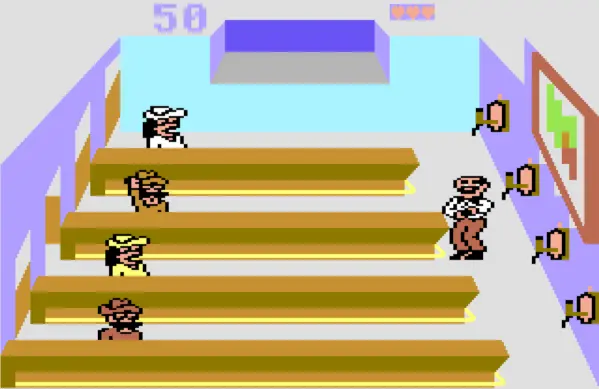
However, ECM has been been enjoying something of a modern revival, with C64 graphicians revisiting this forgotten mode in pursuit of fresh visual styles for the venerable platform.
The demo scene even had an ECM-only competition in late 2020 which, for me, underlined the Commodore 64 scene's
renewed interest in this long-neglected graphical mode.
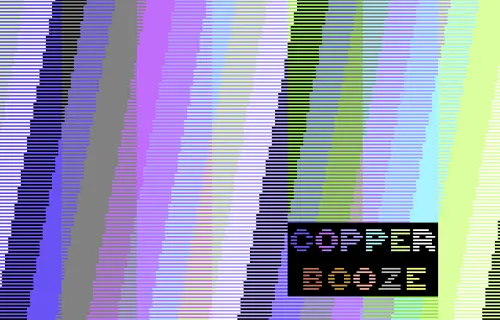
And it's not just the demo scene's interest that has been piqued by ECM of late; more relevantly to my own interests, it's also starting to be embraced by some within the C64 gaming scene.
ECM in Notable Recent C64 Games
I might be wrong in saying so, but I think the first recent era game to really grab everyone's attention for its use of ECM was Retream's
Quod Init Exit, a quirky platformer with a very non-C64, colourful look... courtesy of its liberal use of
ECM.
The image below shows its sequel's work-in-progress playable demo (downloadable from Retream's itch.io page),
which retains the same eye-catching ECM-based graphical style as the original game.
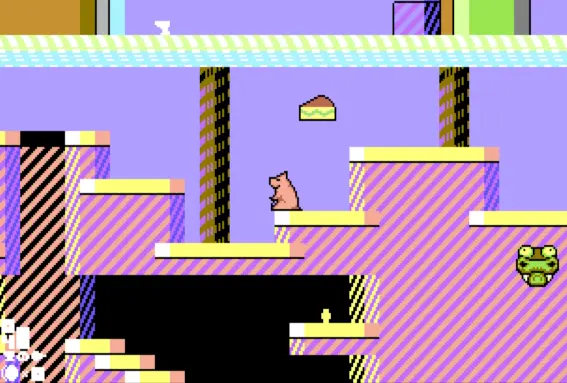
(As a side comment for coders reading this, the game's developer has come up with a jaw-droppingly smart "one read, two writes" technique for rapidly rendering both the chars and their
colours in what represents a feat of coding genius I have never seen the like of before in all my experience with 6502 assembly language programming on the C64 -
read about it in his notes and follow-up comments on this Lemon forum post).
The next extraordinarily skilful deployment of ECM in a Commodore 64 game is shown below in the form of the delightful
Goblin by Vanja Utne (and you can also download a 9-level preview of the game from that link!)
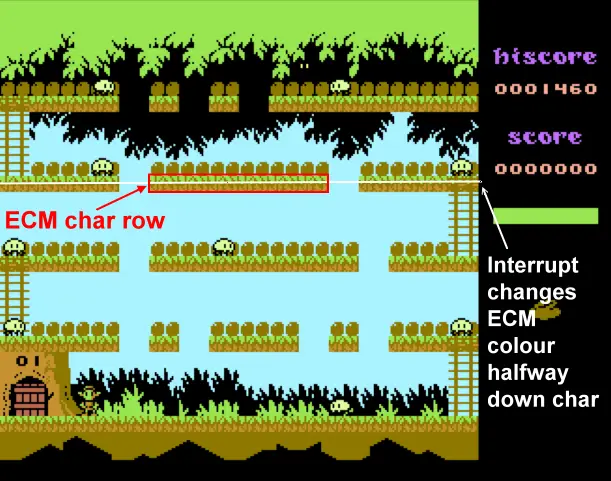
I should point out that a similar or even superior effect might, if there are enough free char space definitions, be obtained by using 2 char rows to simulate a single row
through the sneaky expedient of using the bottom 4 lines of graphics on an upper row and the top 4 lines on a lower row to fake an 8 line deep char row.
This trick would get round the hardware limitation that prevents char colours from being altered mid-char.
Anyway... the final ECM-based game I would like to draw your attention to is the superbly designed
Robot Jet Action, which has five different game worlds that further highlight the sheer freshness and versatility
that the use of ECM graphics brings to the Commodore 64 gaming scene.
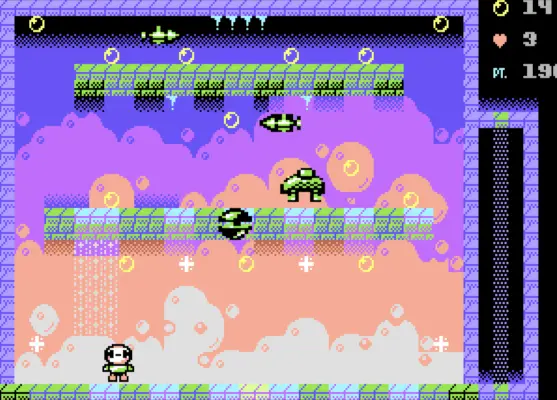
It's also notable that in each of the three recent game examples highlighted above, the graphicians have gone to extra lengths to minimise (in the case of Robot Jet Action) or even entirely
avoid (in the case of the other examples) blockiness in their sprite designs, not just in the backgrounds.
There are hi-res overlays on the player sprites in each game, and in the first two games, even non-player sprites are overlaid to impart a much slicker and dare I say it, "next gen" vibe
to the overall look.
So.. I trust you will agree with me that ECM offers the prospect of a whole new design methodology for Commodore 64 games and, if combined with other clever design choices and the kind of
hyper innovative lateral coding thought evident in Quod Init Exit II, raises the tantalising prospect of a new generation of games that should keep the platform alive even longer.
The Use of ECM in Kodiak's Games?
Obviously, I cannot proffer such lavish praise of ECM as a design option and then say nothing about my own intentions for deploying it, so let's get to the point...
Yes, I do intend to use it and have already done so for the airspace indicator in Parallaxian, but I hope to make
an entire game using it at some stage too.
In the meantime, I need to crack on and finish Parallaxian and its secret prequel that I can't tell anyone about just yet!
Oh, and before you go, kindly check out my latest technical article,
The Future of VSP Scrolling on the C64 and if you
want some further reading on advanced char-based gfx tricks for Commodore 64 game design, take a look at the char-based secrets of Andrew Braybrook's games (Paradroid, Uridium, et al)
in his fascinating C64 Character Modes blog post... his revelations on the bullets used in
Uridium are well worth studying.
So, that's a wrap on this blog post and as ever, if you like anything I am writing or doing, kindly share far and wide ;-)
____
If you value my work and want to support me, a small donation via PayPal would be nice (and thanks if you do!)
Help Make Parallaxian Happen!
...and get special perks!
Progress on Parallaxian has slowed down since summer 2021 for several reasons, one of which has been the very low level of support from
the C64 scene which has made it difficult to continue justifying to my family the long hours of hard work a project as complex as this requires.
Now, I understand these are difficult times and I admit I am not entitled to any support at all, but it really does encourage me to continue developing
this sensational game when you make a regular
Paypal donation.
And as a special thank you, all who do this can enjoy the following perks:
- Your name credited in the game (unless you opt out of it if you have the same kind of incognito hermit tendencies I do).
- Access to the ongoing beta-testing of the game (unless you would prefer not to see it before its release date).
- The finished game on media (e.g. cartridge) for FREE one week before its release.